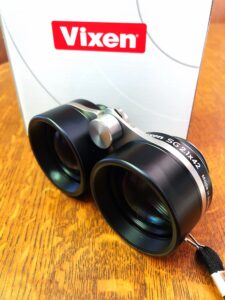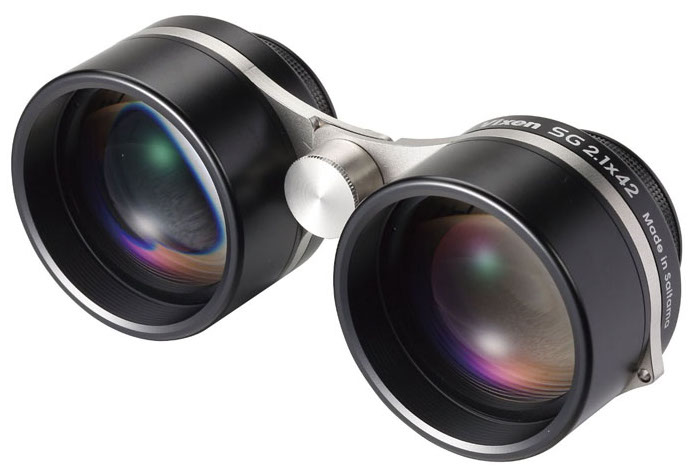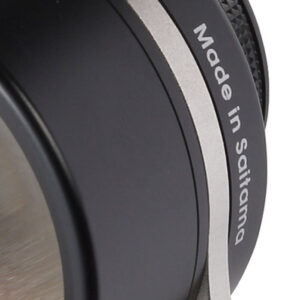
For the second year in a row, the night of the Perseids meteor shower peak will not be the night of my departure for the BirdFair in England. As it was in 2020, the BirdFair is again cancelled due to CoVid-19 for 2021. Consequently, I have the opportunity once again to view what is historically the most visually striking meteor shower of the calendar year.
However this year for my meteor viewing, there will be two important differences from 2020. First, and most importantly, the skies above my northwest Oregon home will be clear (last year it was cloudy). Second, I have recently acquired a very interesting new binocular that I think will be ideal for the purpose: the Vixen SG 2.1x42mm.
Admittedly a very unusual binocular in both its appearance and function, this little Vixen binocular offers three features that make it the ideal instrument for observing meteor showers – as well as a number of other possible subjects, but I won’t take those up here at present. The first of these features, the unusually low 2.1x magnification, allows them to offer the person using them the second – and more important – feature: an extraordinarily wide field of view.
At 25.2° the visual field seen through this binocular is expansive to the point of making it seem as though one isn’t even looking through an optical instrument at all. This, of course, results in a very large area of the sky being visible through them to the observer.
But then, you may ask, is even the purpose of using such an instrument if it’s level of magnification is so low that it can almost be overlooked? It’s a very good question indeed. The purpose is to give the observer just enough magnification to overcome some of the atmospheric distortion and light pollution common to most areas where one might reasonably find oneself when viewing such an astronomical event.

Unless you are a dedicated astronomer, you’re not likely to venture out to a true dark sky sight to do a little stargazing. Your more likely to wish to stay close to home, perhaps visiting a local park for the purpose, or even simply staying in your own back garden, close to a clean restroom and a nice pot of tea. In most such places, there is certain to be a bit of extraneous light as well as perhaps a bit of pollution, haze, heat shimmer, and so forth. The small nudge of the 2.1x magnification gives one just enough optical “oomph” to get past that and see celestial object just that much more clearly and therefore enjoyably. It also provides visibility of celestial objects that are just slightly too dim to be seen with the unaided eye but can be with just this minimal amount of magnification. For meteors, this means seeing many more of them than one otherwise would.
Then there is the third feature of the Vixen SG 2.1x42mm that makes them such a remarkable little optical instrument; the full-size binocular objective diameter. At 42mm, the objective diameter of a typical field binocular that one would use for bird watching or other manner of nature study, the amount of optical throughput (think “light”) transiting the binocular has the potential to be very high. And when this objective diameter is combined with the very low 2.1x magnification level, the diameter of the eyepiece exit pupil (the little circle of light through which one looks to see the image) is – relatively speaking – an enormous 20mm diameter. Consequently, the amount of visible light transiting the optic is extraordinarily high. Such a large exit pupil also makes the binocular very easy to hold in a steady position as it isn’t necessary to position it in “just the right spot” to see the image though it (think of looking through large picture window as opposed to looking through a port hole on a boat).
 Somewhat unsurprisingly, an instrument of such an unusual configuration is not sold in just any shop. And as it is manufactured in Saitama, Japan at one of the world’s top optical instrument laboratories, while not outrageously expensive, it isn’t exactly cheap either. For those in Japan, locating one should be relatively easy – just visit any of the better optical instrument retailers. In the U.S., they are listed for sale on Amazon.com. In the U.K, I’d recommend Focalpoint Optics, or one of the other fine optics specialty shops there. In Germany, try Baader Planetarium.
Somewhat unsurprisingly, an instrument of such an unusual configuration is not sold in just any shop. And as it is manufactured in Saitama, Japan at one of the world’s top optical instrument laboratories, while not outrageously expensive, it isn’t exactly cheap either. For those in Japan, locating one should be relatively easy – just visit any of the better optical instrument retailers. In the U.S., they are listed for sale on Amazon.com. In the U.K, I’d recommend Focalpoint Optics, or one of the other fine optics specialty shops there. In Germany, try Baader Planetarium.
As I indicated, they’ll not likely be easy to find, but as with so many things of exceptional quality and utility in this world, those who perceive what they can do and want to include such an instrument amongst their field kit will make the effort. It’s indeed most certainly worth it.
For those unable, or not interested in undertaking the search that will be necessary to locate one of these little Vixen binoculars, I would also recommend the following (relatively) low magnification, wide field of view models:
- Celestron Ultima 6.5x32mm Porro
- Celestron Ultima 8x32mm Porro
- Celestron UpClose G2 7x35mm Porro
- Celestron LandScout 7x35mm Porro
- Kowa 6.5x32mm BD II XD Wide-Angle
- Kowa 6x30mm YF II Porro
- Opticron 6x30mm Savanna Porro
And, if money is really no object:
